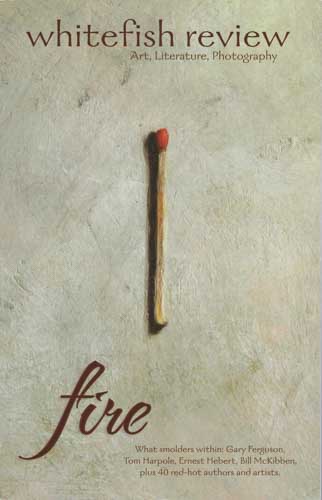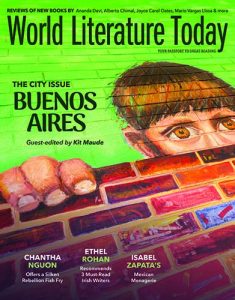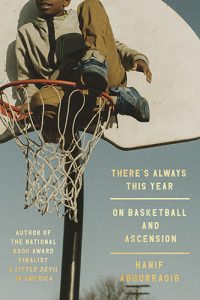Whitefish Review – Summer 2014
Whitefish Review carries a constant byline of “Art, Literature, Photography.” This particular issue carried a special theme of “fire,” and some of its words will continue to smolder inside me for a long time. Poetry, fiction, and visual imagery all have some very bright spots, but the nonfiction entries take the cake! Every page felt like it was making the most of itself to give pertinent information while remaining entertaining. Whitefish Review carries a constant byline of “Art, Literature, Photography.” This particular issue carried a special theme of “fire,” and some of its words will continue to smolder inside me for a long time. Poetry, fiction, and visual imagery all have some very bright spots, but the nonfiction entries take the cake! Every page felt like it was making the most of itself to give pertinent information while remaining entertaining.
The first piece of creative writing, a poem titled “Another Draft” by Jody Gladding, hooked me with its visual presentation and use of blank space. All of the words on the page were arranged to look like a plume of smoke from what my mind visualized as a campfire, and the words continue to linger with me like the smell of so many marshmallow evenings in the woods growing up. Several other poems of varying style and presentation are contained in the issue.
A majority of the visual images are shown on glossy pages in the center of the magazine, which makes for a striking break in powerful words. I found it unique that each visual image was paired with a page-long description by the artist. This provided a more in-depth look at process, meaning, and intention for each piece. My particular favorite was a snapshot of an interactive fire sculpture titled “Dance Dance Immolation” by Kristin Ankiewicz. Much of the inspiration for the piece of art was taken from a popular videogame with the word “Revolution” in the title. Ankiewicz goes on to describe that “eager participants were given protective, full-aluminized proximity suits to wear, and once safely protected, they could take the stage to play.” Based on the action in the photograph, I would not have wanted to get a step wrong!
George Sibley, in “Lying Down with Fire,” gives readers a wonderful inside view at being a “hotshot” crew member. It is an outstanding true look at several of the concerns surrounding traveling firefighting and whether or not we should even be fighting forest fires. Socioeconomic issues seem to be at the base of why the public is willing to put individuals at risk of life and limb. Nature used to be allowed to regulate itself, but now there is a very humanity-centric way of dealing with things, and that’s not always a good thing. Sibley writes, “Los Alamos was almost destroyed in 2000 by a prescription burn that got out of control and burned over 40,000 acres and more than 200 homes—a big reason we no longer call them ‘controlled burns.’” This writing should be required reading for those who live at the fringes.
Tom Joyce takes the more suburban route of thinking while describing his family’s loss in “Rubbish and Epiphanies.” I was left feeling achingly sad for some human I’ve never met in the way of his family lost everything, but then I was immediately reminded to question what is “everything.” Joyce recounted his tale of actually being in his house in the minutes before it burned and then again before the street was reopened after the blaze, feeling his private connection with what was, and used to be, home. His words about the moments before the fire hit read, “And that’s when the fire spoke to me: / 15 minutes. / How do you decide which bits and pieces of your life are worth keeping in only 15 minutes?” I know his truth will stick with me for some time.
My favorite piece of fiction in this issue was written by Andrew Bourrelle. Titled “Inferno,” every part of the story tackled another definition of “fire.” It weaves a fast-paced narrative about sibling love and trying to re-create the past without regard to the future. There is smoke from a wildfire, there is cancer, there is an abandoned amusement park with the titular ride . . . I am always a bit jealous when reading something so concise and complete. Foreshadowing in its finest form shows off early in the story when Bourelle writes, “She smiles, but I can see she’s hurting without the morphine. By the time I get her back to the hospital, she’ll be in agony. But I know she wants to do this.” There are other outstanding pieces of fiction in this issue, but this one captures as many emotions as are humanly possible in a very limited space.
From playing with fire to having fire play with one’s life, this issue of Whitefish Review really looks at all angles. Like the best literary accomplishments, this did not always feel safe or agreeable, but it presented new views in artful manner.
[www.whitefishreview.org]




